What Nurses and Teachers Won by Withholding Their “Feminized Labor”

At the intensive care unit at Abbott Northwestern Hospital in Minneapolis, nurse Kelley Anaas has cared for a lot of people who have gotten sick with Covid-19 during the pandemic.
“I took care of plenty of people who got sick at their work,” said Anaas, who has been a nurse for 14 years and is a steward with the Minnesota Nurses Association (MNA). “I remember taking care of a woman five years older than me, who didn’t make it, who got her job working in a liquor store. Her family’s not gonna get a dime for the sacrifice she made and the choice she didn’t have. I saw the ramifications of that in a much more real way than, you know, lawmakers.”
The surge of collective actions by workers in 2022 indicates momentum in the labor movement. Much of this resurgence has been led by workers on the front lines of the pandemic, who have been most at risk when it comes to health and safety.
Of the hundreds of strikes that began last year, two historic ones occurred in Minnesota, where teachers and nurses withheld their labor to demand better working conditions, hold their employers accountable, and stand up against greed. It is no surprise that workers in teaching and nursing, feminized professions tasked with running institutions on which communities depend, have been militantly raising their voices and risking their jobs to alert their communities to the problems they are facing.
Jobs typically associated with women are considered to be “feminized labor.” Of course, not all teachers and nurses are women, but all workers in these professions still perform labor that’s devalued, because “women’s work” has historically not been rewarded and recognized in the way male-dominated work has. It’s not exactly blue-collar or white-collar work, but a third category often referred to as pink-collar work, a term coined by social critic Louise Kapp Howe.
“Many presume the skills women have in occupations like teaching or childcare work or nursing are innate and that women are naturally good at caring for people,” University of Vermont economics professor Stephanie Seguino told The 19th. “Therefore, there’s a sense that we don’t really need to compensate for that. So, it’s gender stereotyping that really holds down wages.”
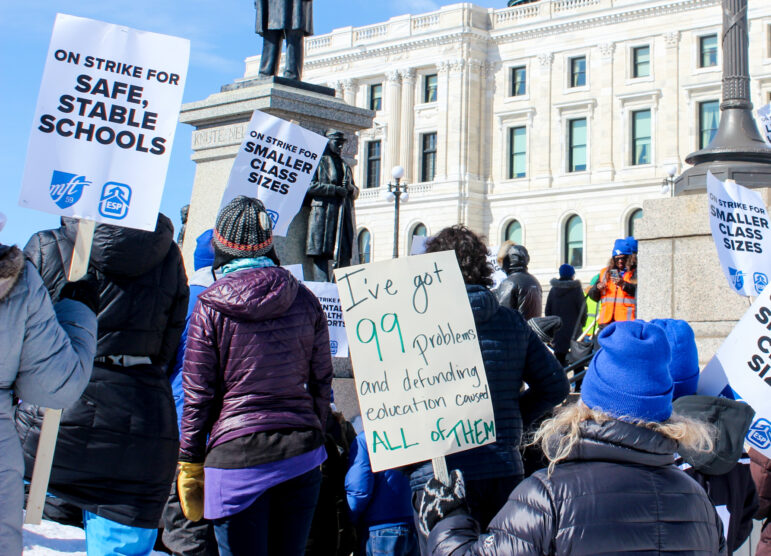
Teachers and community members rallied at the Minnesota state capitol on March 9, 2022. A DFL trifecta in the Minnesota state legislature is looking to pass education legislation this year utilizing a $17.6 billion surplus. Photos by Amie Stager.
When women, who make up the majority of essential workers, belong to a union, they see improved wages and health benefits, and are more likely to work in safer and healthier environments. According to the National Women’s Law Center, women are 77.2% of the workforce in the education and health services sector, which saw union membership increase by 6.3% between 2000 and 2020.
Workers in both healthcare and public education are essential, yet they’re being pushed out of their jobs by burnout, poor pay and conditions, and political attacks. However, tight labor market conditions, alongside public support, can give workers more power at the bargaining table. Workday Magazine spoke with one teacher and one nurse, who both went on strike this past year, about the struggles they’ve been facing as frontline, feminized workers during one of the bleakest times in history.
Teachers come prepared
“The groundwork for our historic strike had been laid by our leadership and membership in previous years getting more organized and mobilized,” said Marcia Howard, who has been an English teacher at Roosevelt High School for 24 years and is also the first vice president of Minneapolis Federations of Teachers Local 59 (MFT 59). “Because we are such a feminized profession, I believed that we would also be complacent, that we wouldn’t have the chutzpah to stand for ourselves. But something happened on the way to the strike—Minneapolis rose up in defense of Black lives.”
In March, around 3,500 teachers with the Minneapolis Federation of Teachers went on a 14-day strike over the span of three weeks (teachers in St. Paul with the St. Paul Federation of Educators Local 28 also voted to strike but were able to reach a deal with their district). This was the first walkout in Minnesota since teachers went on strike illegally in 1970. It also followed the murder of George Floyd on May 25, 2020, which inspired the largest political demonstrations in global history. By the time it came to the teachers’ strike, working people had already been practicing standing up for their community.
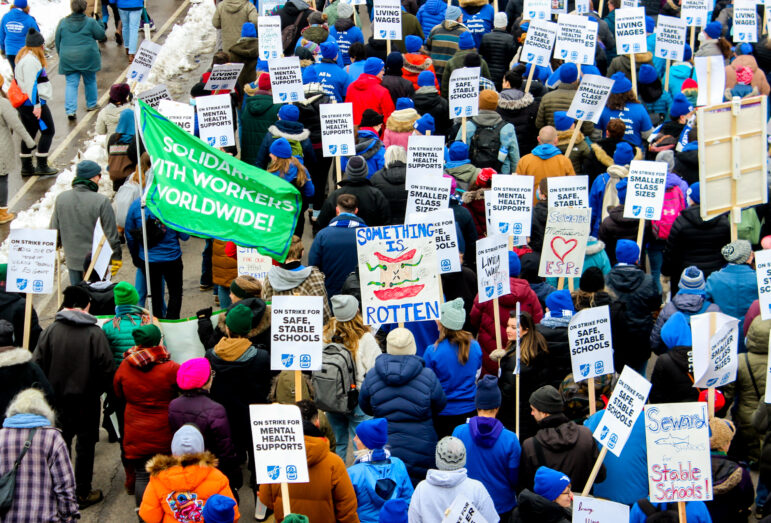
A sea of protestors donning blue hats and jackets moved through North Minneapolis on March 8, 2022.
Public sector workers are excluded from the National Labor Relations Act (NLRA), so whether or not they have the right to organize, bargain, or strike is determined by the law in their state. Public sector workers in some states do not have these basic protections. After teachers in Minnesota went on strike illegally in 1970, the state passed the Minnesota Public Employment Labor Relations Act (PELRA), providing the right to bargain and strike for public workers in the state (though, to this day, certain workers deemed “essential employees” do not have the right to strike). In public education across the United States, women make up 76% of school teachers, according to data from the National Center for Education Statistics in 2018.
Forced to flee the workforce
Labor journalist Sarah Jaffe wrote in Rethinking Schools that the right has targeted teachers for urging the closing of schools during a deadly pandemic, and for teaching racial justice and sex education, and this has created a “pressure cooker” for teachers.
The Economic Policy Institute, a pro-union research organization, reports that the teacher shortage has only worsened since the pandemic, not because there is a lack of qualified teachers, but because the job offers low pay when compared to other professions requiring college degrees, and the work environments are stressful.
The system is breaking teachers faster than they can replace them, according to former Twin Cities teacher Katie Niemczyk, who was a teacher for 11 years before leaving the industry during the pandemic.
“It’s not an outlandish conspiracy theory,” Howard said of right-wing campaigns against teachers. “This capitalist society would find a way to squeeze every dime out and make public money go in private pockets. There are people making decisions that anybody from the outside would say it’s like they want people to flee the district.”
A disproportionate number of women left the workforce to care for family and children during the pandemic (child care and home care are also frontline and feminized industries in crisis). Gender roles are changing, but women are still largely made responsible for the health and wellbeing of our families and communities, through paid and unpaid labor and care.
The strikes by teachers and nurses also occurred during a time when the right to reproductive freedom and access to abortion has been under attack across the United States and denied by the Supreme Court, negatively affecting worsening economic situations brought on by the pandemic. And while more and more women are being represented as leadership in institutions such as elected offices, corporations, and unions, gender bias and inequality across the globe is pervasive. Having women in positions of power does not necessarily improve material conditions for all women.
At the beginning of the pandemic, Howard taught from her front porch. “It was during that time, when on May 25 of 2020, within 253 steps of my front door, George Floyd was lynched. It was filmed by a former student of mine, and my life dramatically changed,” she said. Howard took the next year off in a leave of absence. She’s been a leader at George Floyd Square, where the intersection of 38th and Chicago is still occupied in protest since Floyd’s murder, more than two and a half years later.
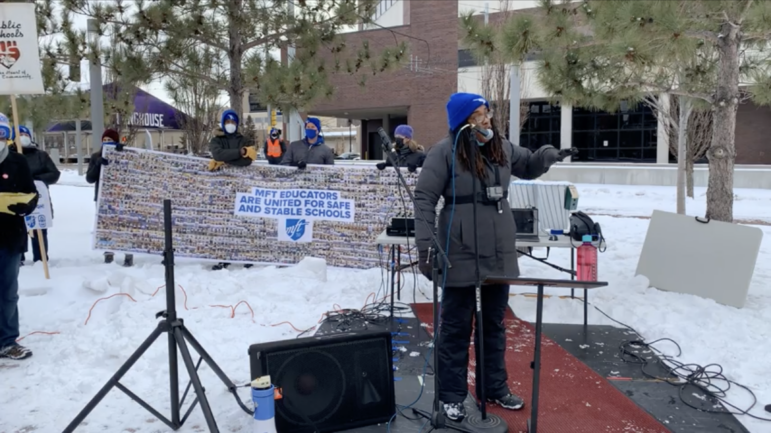
Weeks before the strike began, teachers ralliedon Dr. Martin Luther King Jr. day in 2022 in front of the U.S. Bank Stadium, where Howard addressed the crowd: “Minneapolis has been the epicenter of a global social justice movement and what we have discovered is how interconnected all of it is.”
A world on fire
The last movie Howard showed in class in 2020 was Contagion. “When it became just me and a computer, and disembodied voices, with an icon of their initials, I had to reach back into my bag of skills. How do I get their attention? How do I keep it? How do I make sense?” said Howard. “In a world that seemed to have gone bad, the very first thing that I had to convey to them is that we were in a time outside of time. Between March and May 25, we have a pandemic, after May 25, our world is on fire. My job was to be their teacher, which meant I would turn on Google Classroom and keep it on all day, and make sure that they knew that they have somebody there, while my neighbor has had four of her family members die of covid.”
She returned to the classroom in the fall of 2021 after the teachers’ contract expired in July, and then her union went on strike in March 2022. Demands included raises for education support professionals (ESPs), recruitment and retention of teachers of color, and more mental health support for students.
The teachers knew ESPs, who are predominantly people of color, were receiving poverty wages and often had to work multiple jobs to survive. Howard said she would leave work, go to the grocery store, and see an ESP she worked with during the day working behind the counter.
After striking for three weeks in the Minnesota cold, teachers won raises for ESPs. They also won contract language prioritizing teachers of color over seniority in the event of a layoff, which Howard and MFT 59 president Greta Callahan defended on Good Morning America in response to criticism by conservative local media.
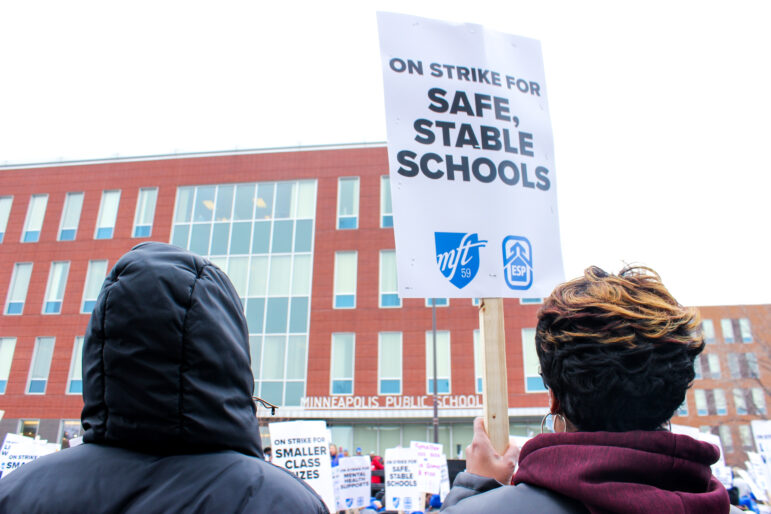
Mitchell Hamline University law professor and Bureau of Mediation Services arbitrator Joseph Daly told the Minnesota Reformer that the protections for teachers from underrepresented communities represents “landmark language” in collective bargaining.
Howard said that to be Black in education is to see the ways her identity is punitively used when teachers and students fail.
“You can bring up Black people and say they’re being failed by public education, or they are inherently failures, for anything you need it to be. It’s pliable,” she said. “Anyone who’s a teacher, the first thing you want to do is self-reflect. Any teacher can think about the ways in which they could have been better, the ways in which they could have changed the curriculum to reach every kid.”
Many students supported the teachers during the strike and walked picket lines, and their parents cooked food for the striking teachers. “I believe that our district did not expect us to get that breadth of support,” said Howard. “That gave us leverage in negotiation, because we knew that they could not bludgeon us with, ‘parents are upset that you’re on the line’.”
What is collective good?
According to the Gender Policy Report by the University of Minnesota’s Center on Women, Gender, and Public Policy, worker-led actions are vital for improving the economic situations for those in public service. But when teachers and nurses go on strike, they can be criticized for harming students and patients. One of the main reasons for the strikes this year was to bring attention to working conditions that make it difficult and sometimes impossible for workers to do their jobs safely and efficiently, which hurts students and patients.
Both teachers and nurses said they didn’t want to go on strike, but withholding their labor was one of the ways they could take action. “When you think about gender perspectives, being a teacher or being a nurse, what they hope is that we care so much about our charges or our patients that we’re willing to accept the bare minimum,” said Howard. “God forbid we stand for ourselves and say, can you pay us the professional salary commensurate with our education and our skillset? And then they look at it and say, what about the kids? Exactly! Teachers’ working conditions are students’ learning conditions.”
Howard teaches International Baccalaureate courses, which are part of an advanced pre-college diploma program. What she focuses on is building psychological wellbeing and critical thinking skills. She just finished a unit on propaganda. “If we can get their critical thinking skills up to par, then they can suss everything else,” she said. “I want them to be able to wield the language, but I also want them to understand the way in which emotive language is used to manipulate them. You need to recognize…are you getting sucked in?”
Howard said as long as she’s breathing, she has hope for her profession. “Not everything can be about profit. What is collective good anymore?” said Howard. “What I see is public education, and I’m gonna fight for it with my last breath.”
Nurses come to the rescue
“I think I was naive enough to think that after everything that nurses went through the last couple of years, that our employers would kind of give us a break. That’s what they’re hoping for, that you’ll be too shocked or too tired or too complacent to fight it,” said Anaas. “It got hard during the post-vaccination part of the pandemic. So many people in the ICU were ending up there because they made a choice. Then you’d have family members on the other end of the phone telling you that you were lying to them as the breathing tube was about to go in, the doctors were lying, this is a hoax.”
In September, around 15,000 nurses with the Minnesota Nurses Association went on strike for three days across the Twin Cities and Duluth. It was said to be the largest private-sector nursing strike in history, and it was covered extensively by the media. In November, nurses voted to authorize another strike over the holiday season, but they ratified a contract addressing their main concerns of chronic understaffing and wages.
According to the U.S. Census Bureau, 76% of all healthcare jobs are held by women, and 87% of nurses are women, most of which work in hospitals. Nurses, who are often overworked under harmful, profit-boosting systems of lean production and management, can suffer from post-traumatic stress disorder and moral injury.
Unlike public educators, nurses often work in the private sector for nonprofit companies, so their collective bargaining rights are restricted in different ways. Under the NLRA, workers are not allowed to strike at a health care institution unless they give a ten-day notice. In Minnesota, teachers can only strike after negotiations reach an impasse.
The strike in September was Anaas’ fourth strike working with Allina Health. Conditions in the emergency room are unlike what she has seen over her 14 years at Abbott, she says. These include long wait times, patients being seen and treated in waiting rooms, and full units staffed with only one or two nurses, according to Anaas.
“For the last three years, our employers limped along on our sense of duty to the profession or a sense of duty to care for human beings, and it’s okay that we’re done with that,” Anaas said. “Everybody has different limits. Some of the people whose limits have been reached have left. And the rest of us are quickly coming up on limits.”
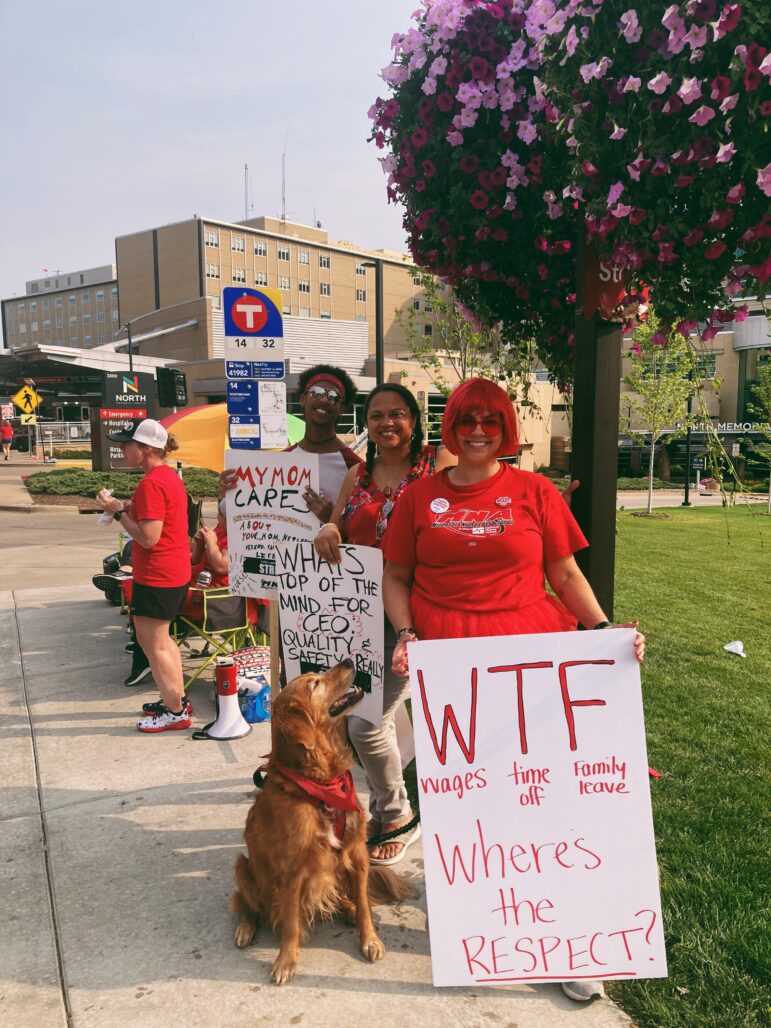
Red shirts, bandanas, wigs, and sunglasses showcase the spirit of the picket line at North Memorial Hospital in Robbinsdale, Minn. in September 2022.
Anaas said she likely would have been laid off as a new nurse during the 2008 recession. However, nurses with more seniority offered to use their paid time off and sick hours so newer nurses could continue working in order to secure the future of nursing. She went on strike with Allina in 2010 and became a union steward after.
“I saw that sacrifice that those nurses made for me, and had an opportunity to pay it forward,” she said. “The public isn’t coming to our rescue, the media isn’t coming to our rescue, because there’s two sides of a story to tell there too, right? We are the only ones who can rescue us.”
Heroism as compensation
The issues affecting nurses in the Midwest are affecting nurses across the country. Around 7,000 nurses at two of the biggest hospitals in New York City with the New York State Nurses Association went on strike for three days over safe staffing before reaching a tentative agreement last Thursday. Health care workers in the United States have been called “heroes” while leaders devalue and disinvest in their industry plagued with financial instability during a mass health crisis. Heroism is often used in place of compensation for those who risk themselves for the collective good. As essential workers throughout the pandemic have repeated over and over again, being glorified in the public imagination is not enough, and it can even feel like a form of cruelty when more pressing needs are neglected.
Allina’s comment in November 2022 calling the strike vote “public theater” was a slap in the face for Anaas, who has become sick herself from working with sick patients. “The public theater was the ‘heroes work here’ signs outside the hospital while they weren’t giving us any kind of hazard pay,” said Anaas. “Me on a picket line on Christmas morning? That’s not theater.”
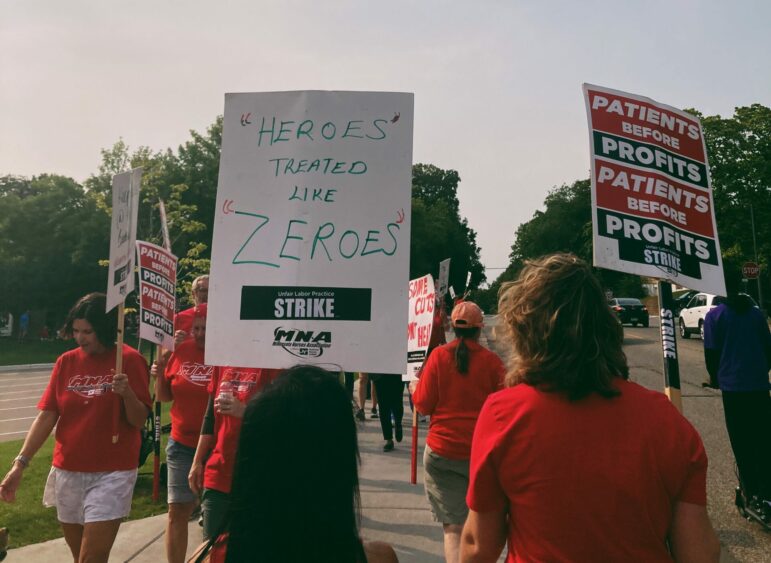
Nurses walking the picket line at North Memorial Hospital in Robbinsdale, Minn.
According to a data analysis by the Minnesota Reformer, four out of the five most dangerous professions in Minnesota involve nursing and residential care. “You’re kind of at a loss after you’ve talked to a nurse who’s been injured,” said Anaas. “This shouldn’t have happened. This isn’t what you signed up for. It’s terrifying.”
Selling their campaign to the public and lawmakers was not hard for nurses. “It was the first time where we really didn’t hear anybody yelling at us, ‘stop being selfish’,” said Anaas. “It was ‘keep going, keep fighting’. I wish our employers would remember that the public, our patients, know what they deserve, too.”
Unseen work
Although the nurses finally got their contract after nine months of negotiation, news of a proposed merger between Fairview Health Services, which partners with the University of Minnesota (disclosure: Workday Magazine is a publication housed in the the Labor Education Service, which is based at the University of Minnesota), and Sanford Health, a hospital company based in the right-to-work state of South Dakota, is causing concern for health care workers. “What happens when an employer buys our system? Is our contract recognized?” said Erika Helling, an RN at Fairview Southdale, at a press conference. “Do we need to fight all over again to keep the high standards and protections our contract provides to the practice of nursing and patient care?”
Minnesota’s state attorney general Keith Ellison has been hosting public meetings on the proposed mergers. In the first meeting, workers in attendance raised concerns about the effect the merger will have on employees and the care they provide, especially for those in need of abortion care, which is illegal in South Dakota.
“We believe every working person in Minnesota needs access to quality healthcare,” Minnesota AFL-CIO president Bernie Burnham said at the meeting, referencing an MN AFL-CIO resolution opposing the merger. “Ten years ago when Sanford and Fairview health systems first attempted to merge, attorney general Lori Swanson organized a public hearing to show that the merger was not in the public’s interest. We believe, at the MN AFL-CIO, that the merger is still not in the public’s interest.”
Nurses are going to continue pushing the Keeping Nurses at the Bedside Act in Minnesota’s legislative session. “We will not stop fighting for staffing and against corporatization of healthcare,” said MNA President Mary Turner.
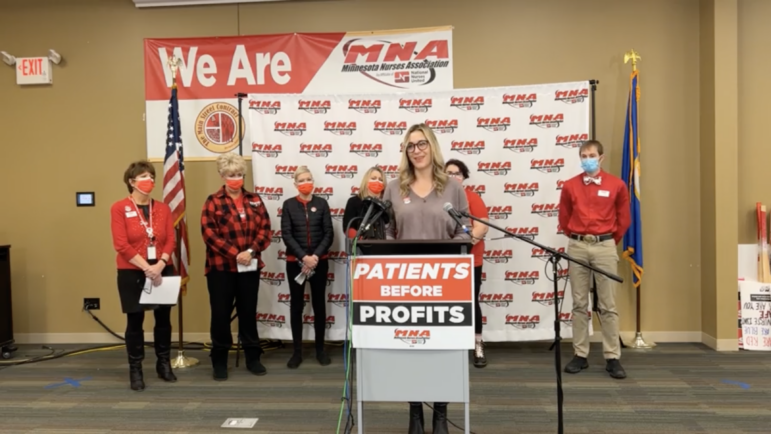
Anaas spoke at press conference
on December 15 announcing the ratification of the new contracts: “Now, we rest, for there is resistance in that, too.”
Anaas, whose mom was a teacher and dad was a firefighter, considered teaching as a career. But she saw the dissatisfaction in the teachers in her family. She figured nursing would satisfy her desire to care for people and educate them.
“Whether you’re a nurse or a teacher or an electrician or working in a grocery store, if you don’t give them a hard boundary, they will continue to walk over you,” she said. “So much of this feels beyond the struggle against our employers, but also the way we’re taking advantage of women and our sense of duty, our unseen work.”
